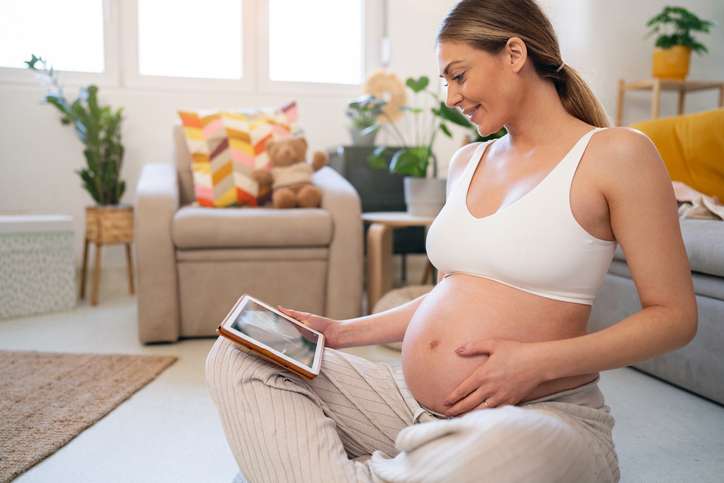Guide to Kick Counts in Pregnancy: Fetal Movement Counting

Expectant parents naturally want to monitor their baby’s progress and keep an eye open for developing issues. The great news is, you don’t need to buy expensive equipment (for example, a home Doppler) to help you do this. All you need to do is count your baby’s kicks.
The time-honored technique of fetal movement counting can tell parents a lot about the health and development of a growing baby. Studying fetal movement patterns can alert parents about developing problems, as well as provide reassurance about a healthy pregnancy.
So, how do you count kicks in pregnancy?
What is Kick Counting in Pregnancy?
A “kick count” is just what it sounds like – counting the number of baby kicks. There are two main ways to do this. You can count the number of kicks a baby does in an hour. Alternatively, you can count the time it takes for your baby to get to ten kicks.
When you do kick counts, it helps you to learn your baby’s movement pattern. Changes in the fetal kick pattern – especially any decrease in movement – are sometimes early warning signs of problems.
How Soon Can You Feel Your Baby Move?
You might have heard the term “quickening.” Quickening refers to when you first start to feel your baby moving around. The usual time for this is between 16 and 20 weeks of pregnancy, though some expectant parents may feel it a bit sooner or a bit later.
First-time parents may have a harder time recognizing those first kicks, as they may feel similar to normal hunger or gas pains (Crider, 2020).
If you have felt no fetal movement at all by 24 weeks of pregnancy, it’s important to discuss it with your healthcare provider.
What Do Baby Kicks Feel Like?
People describe the sensation of baby movements in different ways.
You’ll first begin to feel your baby move in the second trimester. Second-trimester movements have been described as flutters, jabs, bubbles, swoops, or swishes. But not every movement is a fetal kick. You might also feel hiccups, rolls, or your baby’s heartbeat.
By the third trimester, things will be getting cramped inside. Your baby will be getting bigger, stronger, and better developed. You’ll be feeling your baby’s movements more frequently and more intensely (Larson, 2020).
The third trimester is a great time for kick counts, and prenatal visits are an ideal place to discuss any questions and concerns that you might have.

Where Do You Feel The Baby Kick?
This depends on a few things, including where you are in your pregnancy, the position of the baby in your womb, and the position of the placenta (Crider, 2020).
A baby’s movements will feel different at different points in your pregnancy. Early on, you may feel fluttery movements just below your belly button. As your due date approaches, it’s more common to feel stronger kicks and jabs near the ribs and lower in the pelvic area.
If your baby is in the breech position, that is, with their head up and feet down, you’ll feel the kicks lower down in your abdomen.
If your baby is in the vertex position — head down and feet up — you’ll probably feel their kicks higher up, near your ribs.
For babies in the transverse position, that is lying side to side, you’ll most likely feel kicks on the left side or right side, depending on where your baby’s feet are.
The placenta usually attaches itself to the top or side of the uterus. Sometimes, though, it may attach to the front. This is known as the anterior placenta. Anterior placenta is completely harmless (Nall, 2021).
It’s nothing to worry about, but it may keep you from feeling your baby’s movements until later in your pregnancy. It may also mean that your baby’s movements will not feel as strong.
It’s important to note that different babies have different activity levels. Some may move around more than others. This is why it’s important to establish what is normal for your baby.
What Can Fetal Movement Counting Tell You?
Fetal movements can help you to tell a lot about your baby’s well-being and development.
The most important concern is if your baby is moving less than usual.
While you may have simply caught your baby while they were napping, there are other more serious reasons that your kick count may show a decrease.
Decreased fetal activity could be a sign that your baby’s growth has slowed down. It could also mean problems with the placenta, uterus, or umbilical cord. If your pregnancy is high-risk, it’s important to report any decrease in fetal activity to your doctor at once.
On the other hand, if your baby is moving around more than usual, that can mean that your baby is very large for its age (LGA) (Huang et al., 2019).
You should also discuss this with your doctor, as it could cause problems for both parent and child during and after labor.
When to Talk to Your Doctor About Fetal Movement
If your baby’s movements slow noticeably or stop abruptly, talk to your doctor as soon as possible. Your doctor will be able to do an ultrasound and check your baby’s heart rate to determine if further action is needed.
You should also let your doctor know if your baby’s movements significantly increase in frequency.
Of course, if you have any questions or concerns, you should contact your healthcare provider. That’s what they’re there for.
What is a Normal Fetal Movement Pattern?
Babies are individuals, even in the womb. Some are more active than others. Fetuses also have cycles of activity and sleep, just like the rest of us. But there are some commonalities across individuals that you may notice.
You may feel your baby’s movements more as you’re settling down to go to bed. Many babies are most active between 9:00 PM and 1:00 AM (Watson, 2023).
Some people believe that your movement during the day rocks the baby to sleep.
Also, at bedtime, you may have the time and quiet to pay better attention to the movements.
You might also notice your baby moving around more after you’ve eaten. This is because of the increase in glucose (blood sugar).
Average Number of Kicks During the First Trimester
Most people don’t feel a baby’s kicks during the first trimester.
Average Number of Movements During the Second Trimester
Most expectant parents will feel their baby’s first movements toward the end of the second trimester. There is no average number of movements to aim for during the second trimester of pregnancy.
Average Number of Times Your Baby Will Kick During the Third Trimester
During the third trimester, healthy babies should kick ten times per hour. If, after two hours, you have not felt six to ten kicks, contact your healthcare provider (Penn Medicine).
How to Count Fetal Kicks: Step by Step
Are you ready to count those kicks? Let’s go!
What You’ll Need
- A comfortable, quiet place to sit or lie down
- A pen/pencil and paper
- A clock or timer
Step 1: Choose Your Method
There are two kick counting methods to choose from.
The American Congress of Obstetricians and Gynecologists (ACOG) recommends timing how long it takes you to feel your baby moving ten times. Ideally, you should feel those ten kicks within two hours.
Alternatively, you can count the number of kicks your baby does every hour.
Step 2: Choose Your Time of Day
You’ll be establishing a pattern, so it’s important to do your kick counting at around the same time every day.
Pick a time when things are generally quiet, and you can concentrate. If you usually feel your baby move more at a certain time of day, this is a good time to aim for.
Remember that most babies are more active late at night.
Step 3: Get Comfortable
You’re going to be there for a while, so get comfy. Many moms-to-be like to lie down or sit with their feet up. Minimize distractions such as television, smartphones, and other children/family members, so you can completely focus on noticing the different fetal movements and kick patterns.
Step 4: Location, Location, Location
Remember that your baby’s position can affect how and where you’ll feel their kicks.
Is your baby facing head down? Then feel higher in your abdomen for the kicks.
If your baby is in a breech position (feet down), place your hands lower on your abdomen.
And if your baby is in a transverse position (side to side), then place your hands on the side where your baby’s feet are.
Step 5: Start the Clock
Set a timer on your phone or clock.
If you’ve chosen the “number of kicks in an hour” method, set the timer for an hour and count the kicks.
If you’ve chosen the “how long does it take to get to ten” method, don’t set a timer, but simply keep your eye on the time.
Step 6: Record Your Results
After a few sessions, you’ll start to notice a pattern. Every fetus’s pattern is a little different. This pattern is the important part.
Keep a record of your results to share with your healthcare provider.
How Often to Count Kicks During Pregnancy
Your healthcare provider can tell you how often you should count your baby’s kicks.
Once you’ve established your baby’s activity pattern, look for kick counts that don’t follow that pattern. That means significantly fewer or more kicks per session than usual.
How to “Wake Up” a Sleepy Fetus
If your baby’s movements seem a bit sluggish, your baby may just be a bit sleepy. Here are a few things you can try to wake it up.
- Drink some juice or other sweet drink
- Have something to eat
- Walk around
- Lie down on your left side
- Play music
Are You Ready to Get Counting?
Kick counting is an easy, inexpensive way to monitor your baby’s health. It’s painless, non-invasive, and can be a special time of day to relax and bond with your growing baby.

